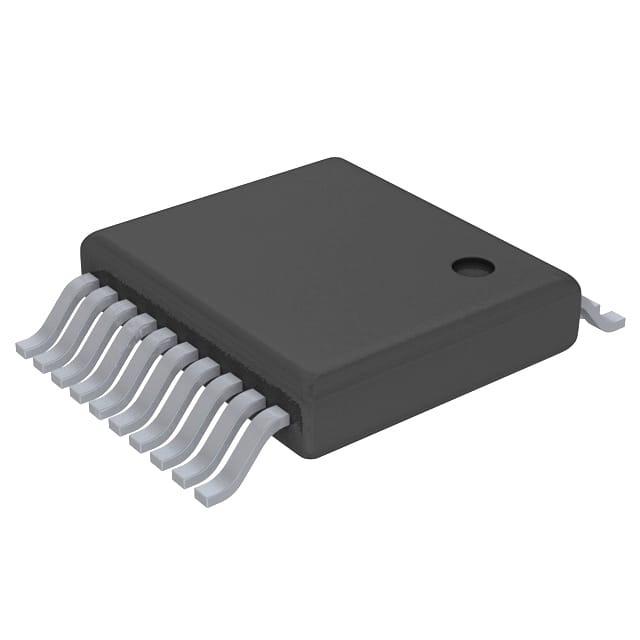Xem thông số kỹ thuật để biết chi tiết sản phẩm.

SN74CBT3345DGVR
Product Overview
- Category: Integrated Circuit
- Use: Digital Switch
- Characteristics: High-speed, low-power consumption
- Package: VSSOP (Very Small Outline Package)
- Essence: Bidirectional Transceiver
- Packaging/Quantity: Tape and Reel, 2500 pieces per reel
Specifications
- Supply Voltage Range: 2V to 6V
- Number of Channels: 8
- On-State Resistance: 5Ω (typical)
- Bandwidth: 500MHz (typical)
- Input/Output Capacitance: 4pF (typical)
- Operating Temperature Range: -40°C to +85°C
Detailed Pin Configuration
- OE (Output Enable) - Active Low Output Enable
- A0-A2 (Address Inputs) - Channel Selection Inputs
- B0-B7 (Bidirectional Data I/O) - Data Inputs/Outputs
- GND (Ground) - Ground Reference
- VCC (Supply Voltage) - Positive Power Supply
- DIR (Direction Control) - Direction Control Input
- NC (No Connection) - No Connection
- OE (Output Enable) - Active Low Output Enable
Functional Features
- Bidirectional data transmission between two buses
- Wide supply voltage range allows compatibility with various systems
- Low on-state resistance ensures minimal signal distortion
- High bandwidth enables high-speed data transfer
- Output enable control for power-saving operation
- Direction control for flexible data flow management
Advantages
- Versatile digital switch suitable for a wide range of applications
- High-speed performance ideal for data-intensive systems
- Low power consumption for energy-efficient operation
- Compact package size saves board space
- Easy integration into existing circuit designs
Disadvantages
- Limited number of channels may not be sufficient for complex systems
- Sensitivity to voltage fluctuations may require additional voltage regulation circuitry
Working Principles
The SN74CBT3345DGVR is a bidirectional transceiver that allows data transmission between two buses. It operates by controlling the direction of data flow using the DIR pin. When DIR is set to logic low, data flows from the A bus to the B bus, and when DIR is set to logic high, data flows in the opposite direction.
The OE pin enables or disables the outputs of the device. When OE is set to logic low, the outputs are enabled, allowing data transmission. Conversely, when OE is set to logic high, the outputs are disabled, effectively isolating the device from the buses.
Detailed Application Field Plans
Data communication systems: The SN74CBT3345DGVR can be used in various data communication systems, such as Ethernet switches, routers, and network interface cards, to facilitate bidirectional data transfer between different buses.
Test and measurement equipment: This digital switch is suitable for use in test and measurement equipment, such as oscilloscopes and logic analyzers, where multiple data sources need to be connected and switched for analysis purposes.
Industrial automation: The SN74CBT3345DGVR can be employed in industrial automation applications, including PLCs (Programmable Logic Controllers) and robotic control systems, to enable efficient data exchange between different subsystems.
Consumer electronics: This integrated circuit finds application in consumer electronics devices like gaming consoles, set-top boxes, and audio/video equipment, where it facilitates seamless data transfer between various components.
Detailed and Complete Alternative Models
- SN74CBT3257CDBQR: 8-channel bidirectional analog/digital switch with similar specifications and package.
- SN74CBT16212ADGGR: 24-bit FET bus switch with similar characteristics and package.
- SN74CBT3257CPWR: 8-channel multiplexer/demultiplexer with comparable features and package.
(Note: The above alternative models are provided for reference purposes and may require further evaluation based on specific application requirements.)
Word count: 550 words
Liệt kê 10 câu hỏi và câu trả lời thường gặp liên quan đến ứng dụng SN74CBT3345DGVR trong giải pháp kỹ thuật
Sure! Here are 10 common questions and answers related to the application of SN74CBT3345DGVR in technical solutions:
Q: What is SN74CBT3345DGVR? A: SN74CBT3345DGVR is a type of integrated circuit (IC) commonly used as a bus switch or multiplexer/demultiplexer in digital systems.
Q: What are the key features of SN74CBT3345DGVR? A: Some key features of SN74CBT3345DGVR include low ON-state resistance, wide voltage range compatibility, bidirectional operation, and low power consumption.
Q: How does SN74CBT3345DGVR work as a bus switch? A: SN74CBT3345DGVR connects or disconnects multiple input/output lines to a common bus based on control signals, allowing for efficient data transfer between different components.
Q: Can SN74CBT3345DGVR handle both analog and digital signals? A: No, SN74CBT3345DGVR is primarily designed for digital signals. It may not provide optimal performance for analog applications.
Q: What is the maximum voltage level that SN74CBT3345DGVR can handle? A: SN74CBT3345DGVR can typically handle voltage levels up to 5.5V, making it compatible with various digital systems.
Q: How many channels does SN74CBT3345DGVR have? A: SN74CBT3345DGVR has 8 bidirectional channels, allowing for simultaneous switching of multiple signals.
Q: Can SN74CBT3345DGVR be used in high-speed applications? A: Yes, SN74CBT3345DGVR is designed to support high-speed data transmission, making it suitable for applications with fast switching requirements.
Q: What is the power supply voltage range for SN74CBT3345DGVR? A: SN74CBT3345DGVR typically operates within a power supply voltage range of 4.5V to 5.5V.
Q: Does SN74CBT3345DGVR have built-in ESD protection? A: Yes, SN74CBT3345DGVR incorporates built-in electrostatic discharge (ESD) protection, enhancing its reliability in harsh environments.
Q: What are some common applications of SN74CBT3345DGVR? A: SN74CBT3345DGVR is commonly used in applications such as data communication systems, computer peripherals, memory interfaces, and general-purpose digital systems.
Please note that these answers are general and may vary depending on specific datasheet specifications and application requirements.

